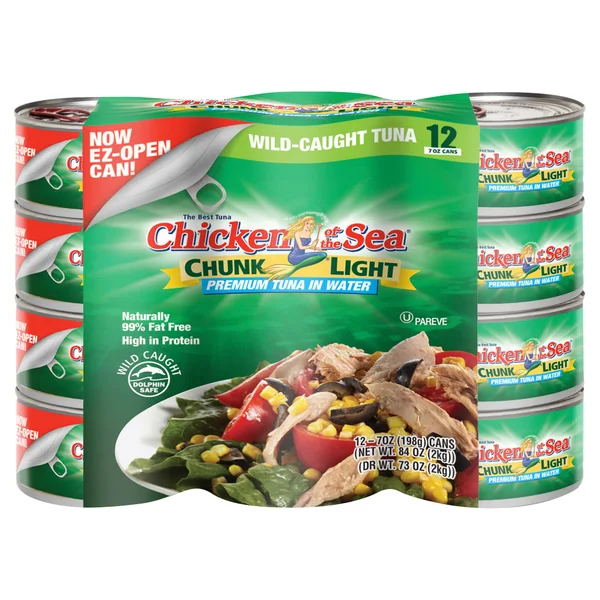Bigeye Tuna, Yellowfin Tuna, Albacore tuna, skipjack Tuna – Katsuobushi and Canned Tuna, Chicken of the Sea
Bigeye Tuna, Yellowfin Tuna, Albacore tuna, skipjack Tuna – Katsuobushi and Canned Tuna, Chicken of the Sea

Bigeye Tuna - Thunnus obesus – market value and taste etc
Bigeye tuna looks similar to yellowfin tuna, however bigeye tuna like the name has larger eyes and have a black lining on the pectoral fins(side fins) that distinguish them from yellowfin tuna.
Bigeye tuna are also a delicacy ranking next after the bluefin tuna species in terms of market value. Bigeye tunas are leaner than bluefin tuna, however they also have enough oily contents that make a distinctive flavor.


High end tuna restaurants usually serve bluefin tuna or big eye tuna as these have the highest oily contents among all the tuna species.
Bigeye tuna live all around the world and these are also highly migratory. The term ahi tuna refers to the bigeye tuna and the yellowfin tuna species.




Yellowfin Tuna - Thunnus albacares – market value and taste etc
Yellowfin tuna are lower in terms of market value than the bluefin tuna and the big eye tuna species.
Yellowfin tuna are also a delicacy but as they are much leaner than bluefin tuan and the bigeye tuna, they are considered a lower grade in terms of sushi and sashimi.



Still, the lean flavor make it rather very healthy steak material and it still has a good flavor profile just not adequate for sashimi and sushi, eaten raw.
The yellowfin tuna has distinctive yellow patterns on its body and it the second fins on both ventral(belly) and dorsal(back) sides that are very long and yellow colored.




Albacore Tuna - Thunnus alalunga– market value and taste etc
The albacore tuna also has large eyes but it has a rather dark blue and silver body without much yellow colors and has a distinctively long pectoral fins(on the side) that make it stand out from other tuna species.


While the bluefin tuna are considered the most highly valued tuna species for sashimi and sushi, followed by the bigeye tuna and the yellowfin tuna, albacore tuna and white tuna species are considered the least valued tuna species for raw consumption.
Still the albacore tuna is also good for steak as it is very lean. Canned tuna made with albacore tuna and yellowfin tuna are considered bit more tasty than skipjack tuna cans.




Skipjack Tuna - Katsuwonus pelamis – Misconceptions as a tuna and a bonito
Skipjack tuna is known as katsuo, oceanic bonito. However technically the skipjack tuna is not a tuna and it is rather more related with mackerel and it is not in the Thunnus which is the “real” tuna family. The term katsuo literally means a ‘fake tuna’ in Japanese(カツオ, かつお).
Also skipjack tuna are called the oceanic bonito but the bonito or sarda is a different fish also known as the hakatsuo(ハガツオ) that is a totally different fish that just looks alike.




Skipjack Tuna – Commercial Importance in cuisines and cultural value
Regardless of whether it is a true tuna or not, skipjack tuna are very important in many cultures as it has been important protein sources and ingredients worldwide in many cultures.
Skipjack tuna are found throughout the world and in Asia, American, European, African and many other cultures, it has served as an important food source.




In south east asia, skipjack tuna has been an important protein source where in Indonesia it is called cakalang.
Japanese cuisine also utilizes skipjack tuna, the katsuo where it is steamed, dried and fermented into flakes called katsuobushi that is an important seasoning and ingredient for Japanese cuisine. It is also served raw, but the irony taste makes it a sushi specifically for enthusiasts.




Katsuobushi and Skipjack tuna – かつおぶし, world’s hardest food
The term katsuobushi refers to all the flakes made from katsuo, skipjack tuna while honbushi refers to katsuo flakes not fermented.
Katsuobushi is made by filleted katsuo, skipjack tuna that is steamed then smoked and then fermented(it may not) with the Aspergillus glaucus fungus and then dried out.




The final product of the katsuobishi is hard as rock and it is recorded as the world’s hardest food and requires a special shaving board called the katsuobushi kezuriki.
The long fermented 枯れ節 garebushi is considered the hardest katsuobushi in the world where it would need a specialized blade to make flakes and it is even harder than rocks.




Katsuobushi – Essential ingredient for Japanese cuisine – Umami and Inosinic Acid
Along with konbu(dasima, haidai) kelp, katusuobushi is essential in making the Japanese ‘dashi’ which means broth in Japanese cuisine.
Also the katsuobushi flakes are important ingredients for several Japanese dishes that make a strong umami taste.


Katsuobushi has a high Inosinic acid content that makes the umami flavor. Inosinic acid is one of a precursor that could synthesize AMP(Adenosine Monophosphate) where it could become ADP and ATP with phosphate ions and serve as energy for our body.


Tuna species used for Canned tuna
Skipjack tuna, albacore tuna, yellowfin tuna are usually caught for making canned tuna as they are lean and adequate to make canned tuna.
Bigeye tunas are also sometimes used as canned tuna; however it isn’t preferred as bigeye tuna could be sold at a much higher prices as an ingredient rather than being canned.




Canned Tuna – Why tuna is called the chicken of the sea
Tuna has been called the chicken of the sea where in Japanese it also says シーチキン (shi-chikin) that translates as sea chicken.
The term “Chicken of the Sea” is literally a tuna can company that used the phrase “chicken of the sea” to promote tuna cans for marketing.




The company Chicken of the Sea first made tuna cans popular to the public and established the canned tuna market.
When canned tuna first entered the market, it was difficult to promote the taste of canned tuna. However, the phrase chicken of the sea soon earned great popularity and it became a general term to describe the taste of tuna.


Canned Tuna Industry of South Korea – Why tuna cans are used as holiday presents
The major companies of the canned tuna industry of South Korea are Dongwon F&B, Sajo Daerim and Ottogi. Dongwon F&B first started the canned tuna business in South Korea and it is still one of the major leading companies of the canned tuna business.
In fact, StarKist Tuna is one of the subsidiaries fully owned by Dongwon F&B and it is one of the major tunas can companies leading U.S. market as well.




Dongwon canned tuna even premiered in the movie Godzilla 1998 as it was mistaken as a Japanese canned tuna company.
Dongwon tuna first promoted and marketed canned tuna as a ‘premium’ food in the 1980’s where South Korea hasn’t completed much economic growth yet.
In the 1980’s of South Korea, while jajangmyeon was 600 KRW and considered a premium food to eat out, a single tuna can cost 1,000 KRW.




Dongwon tuna promoted canned tuna as premium food where developed countries enjoyed. Dongwon F&B has significantly grown by the successful establishment of canned tuna in South Korea.
Thus, Dongwon F&B’s successful initial marketing strategy of canned tuna as a premium food is still effective as canned tuna are packaged as presents and gifts for holidays.
In the 1980’s canned tuna was a premium food so it was considered a high value gift and the customs still seem to remain in the 2020’s.



